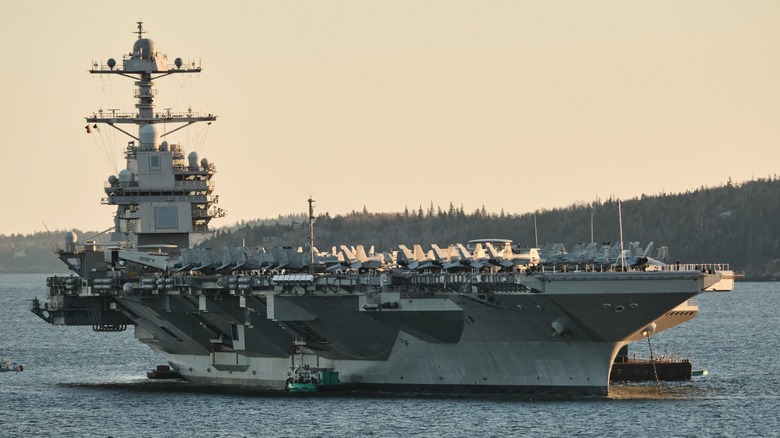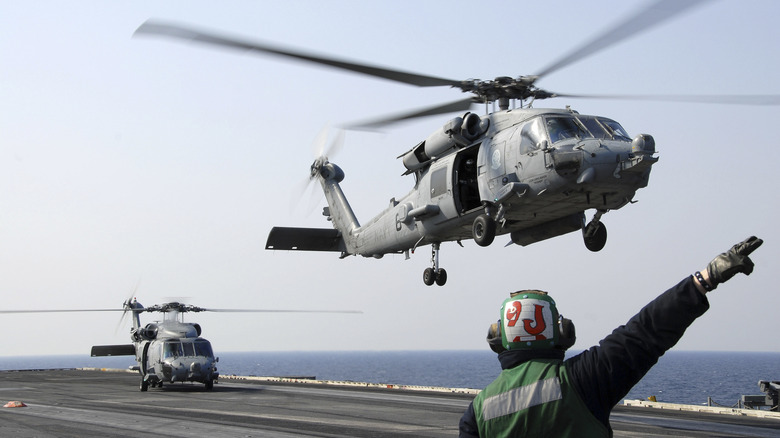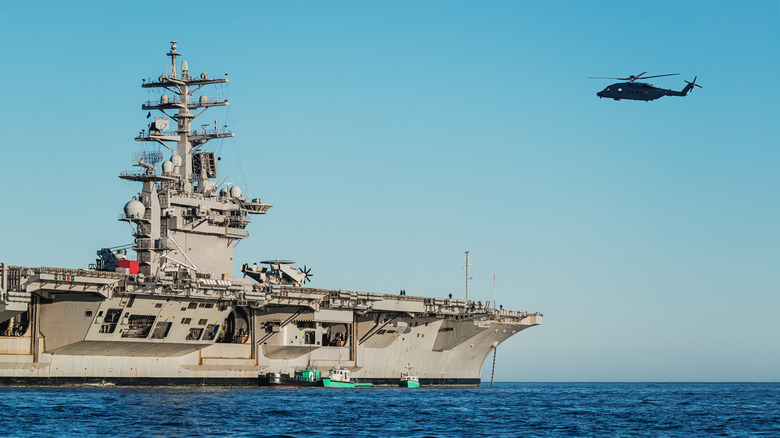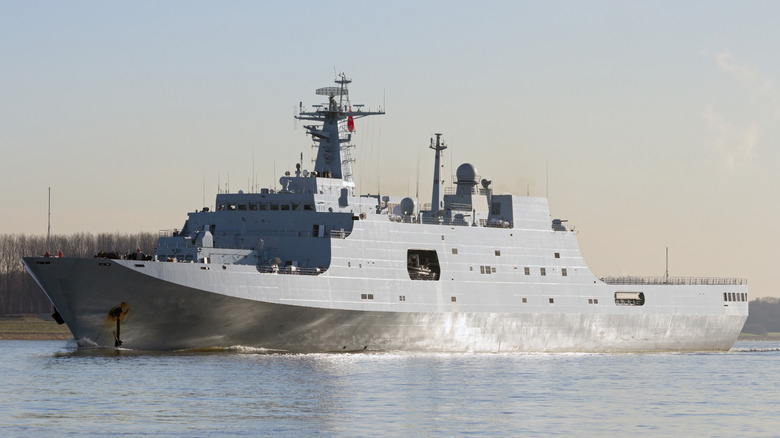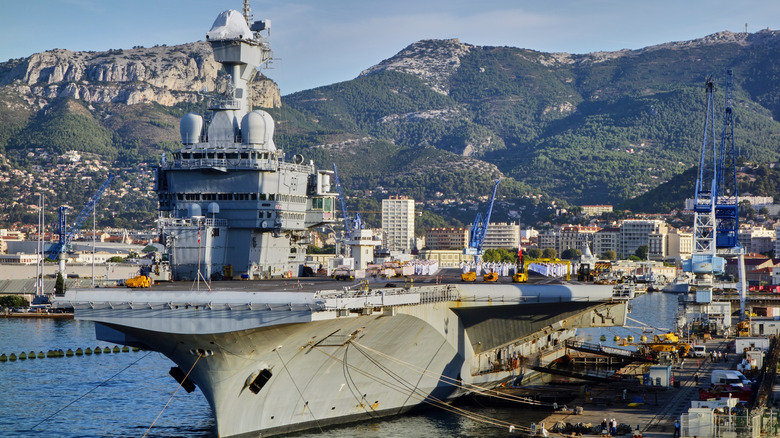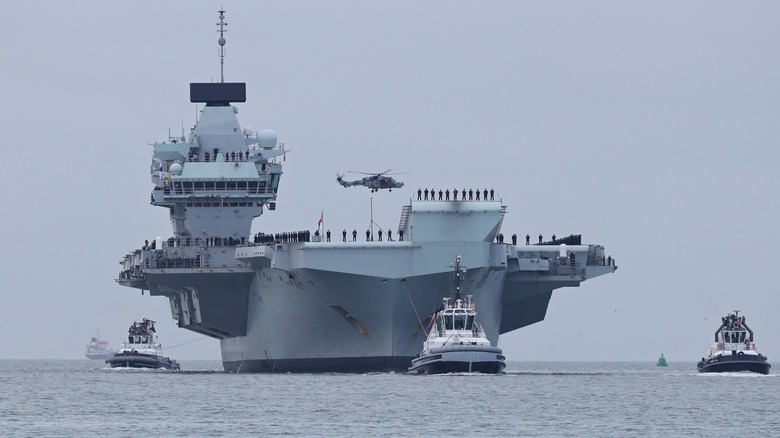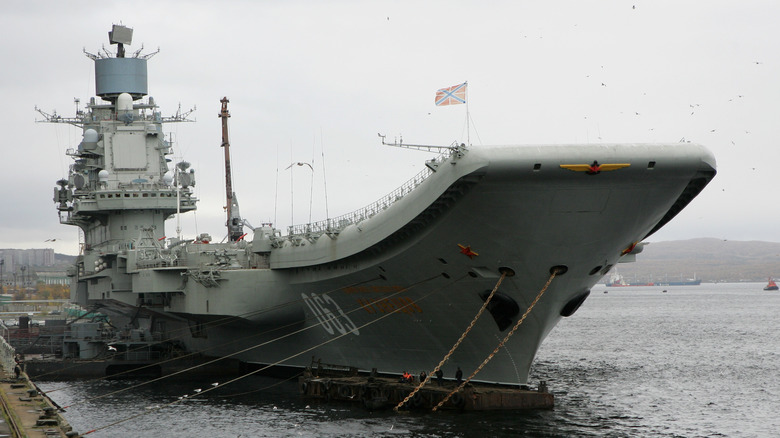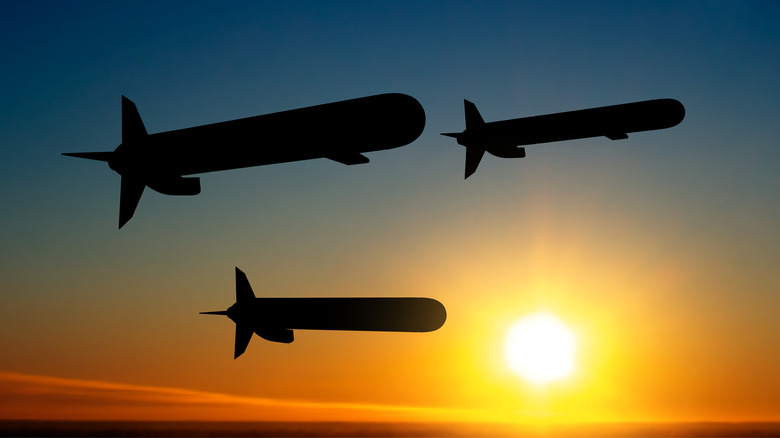Here's How Many Aircraft Carriers Each Country Has
The nuclear-powered aircraft carrier may be one of the greatest combined arms ever developed. The USS Gerald R. Ford, commissioned in 2017, is the latest and greatest addition to the United States' naval arsenal. A top-secret pair of nuclear reactors power the ship, meaning fuel concerns do not limit its range. It travels with a fleet of support and defense vessels whose mission is to service and protect the $13 billion craft and its crew of over 4,500 sailors. At 1,092 feet long and weighing 90,000 tons, it seems impossible that the Navy ship even floats. But its not just the ship's dimensions, scale, and cost that drops jaws.
The power a modern nuclear aircraft carrier can wield is nothing short of stunning. The Ford accommodates dozens of aircraft, up to 75 fighter and attack planes, and electronic warning craft for signals and surveillance. It carries medium-range surface-to-air missiles, anti-ship gun platforms, helicopters, and any number of military personnel, including Navy SEAL teams and Marine infantry.
A properly screened and escorted aircraft carrier group is virtually invulnerable. Its immense power projects American influence around the world. Developing such a capability has required untold amounts of time, mountains of money, and decaudes of engineering and nautical know-how and expertise.
Only fifteen nations around the globe can claim to be carrier powers — less than twice the eight nations with nuclear weapons. And not all aircraft carriers are created equal. Only one nation powers its carrier with a nuclear reactor. Six field conventional flattop carriers, while the other nine are relegated to helicopter carriers. Let's look at which nations maintain these ships, and how large their carrier fleets are.
Aircraft carriers vs. helicopter carriers
Before we get to the list what everyone's got, it's improtant to know that not all aircraft carriers have the massive nuclear bulk of the technologically superior USS Gerald R. Ford. Carrier capability comes in different shapes and sizes. While the Ford and its other American counterparts are the most advanced aircraft carriers in the world, there is a hierarchy for carrier capability.
Full-fledged aircraft carriers are essentially short runways on the water. They have primarily flat flight decks with specialized equipment for flight operations. Steam catapults launch planes off of their short runways, and pilots must hook a wire laced over the deck to bring their aircraft to a stop upon landing. The capability of these carriers to conduct offensive operations around the globe is considerable, while the nations deploying helicopter carriers do not have the same power.
As the name suggests, helicopter carriers primarily deploy helicopters in anti-submarine and amphibious assault roles. They can also be retrofitted to accommodate vertical takeoff and landing fighter jets for offensive operations.
Possessing one or more types of aircraft carriers can greatly magnify a nation's power at sea. Projecting force thousands of miles from home shores is not just a valuable geopolitical tool: It's a strategic necessity nations have been striving to master since naval warfare took to the sky.
More than five aircraft carriers: the United States
The United States is by far the undisputed aircraft carrier champion of the world. As the world's sole superpower, the U.S. uses its carrier fleets to deliver military force to theaters of war. During the recent wars in Iraq and Afghanistan, carrier groups staged flight operations from the Arabian Sea and Persian Gulf.
The U.S. also uses carriers and support fleets to signal intention and calm unrest. After the October 7, 2023 attack on Israel by Hamas, the U.S. positioned two carriers in the eastern Mediterranean. Carriers are powerful signals of intent and force projection even when not actively utilized for combat operations.
The United States currently operates 11 aircraft carriers and nine helicopter carriers, though they are never deployed simultaneously. A rotation of deployment, maintenance, and preparation keeps the majority in port while a handful patrol the planet. Recent overhauls include equipping and training carriers and crews to deploy the fifth-generation F-35 fighter jet.
At $11 billion each, with a further $5 billion or so for their aircraft allotment, no other nation on the planet can even get close to fielding the same number of aircraft carriers. The complement of air power available from American aircraft carriers is enormous. The U.S. Navy can field approximately 3,700 aircraft, making it the second largest airforce in the world, behind only the U.S. Air Force's roughly 5,300 planes. That's right, the United States of America has the two largest air forces in the world.
Five aircraft carriers: People's Republic of China
Currently able to muster two aircraft carriers and three helicopter carriers, the People's Republic of China has a carrier force a fraction of the U.S. Navy's. Still, it's enough to place it next on the list.
China arrived late to the carrier game, commissioning its first in September 2012. The Liaoning is a 990-foot aircraft carrier. Initially without aircraft, it was first used as a training platform for China's force-projection goals. The Chinese navy converted its first carrier from a Soviet leftover carrier named the Varyag, which was left unfinished upon the collapse of the USSR.
China's second aircraft carrier, the Shandong, launched in December 2019. The Chinese navy also has a trio of helicopter carriers: The Hainan, Guanxi, and Anhui joined the fleet between April 2021 and October 2022.
China has yet to perfect its operation of aircraft carriers. Launching and recovering aircraft at sea is intensely complex and dangerous, and their relatively recent arrival to the arena has the PRC playing catch up. However, tensions in the South China Sea have been rising in recent years, as illustrated by a cruise past the eastern shore of Taiwan by the Shandong last May.
Like America's posturing in the Eastern Mediterranean after the October 7 attack, China's aircraft carriers have more use for propaganda and geo-political theater — for now.
Four aircraft carriers: Japan and France
Two nations tie for third-most carriers. Japan and France each count a quartet of carriers in their fleets. However, France technically gets an edge as its fleet includes a full-fledged nuclear-powered carrier, while Japan's four are exclusively for helicopter deployment.
France's flagship carrier, the Charles de Gaulle, is something of a relic. Begun in a Brittany shipyard in 1987 and originally named the Richelieu, economic issues paused its construction no fewer than four times. The ship wouldn't see sea trials until the late 1990s. Compared to the 2019 completion of China's Shandong and the 2022 deployment of the American Gerald R. Ford, France's carrier is positively ancient. Still, one special characteristic puts it in the top tier of operational carriers: It is the only nuclear-powered carrier outside of the American fleet. Undergoing a pair of overhauls, it participated in support of the U.S.-led war in Afghanistan in 2001 and 2002.
Japan exclusively operates helicopter carriers as part of its naval forces. After having its fleet annihilated during World War II and undergoing an internationally mandated reduction of military force, Japan's re-entry into the carrier game is a recent development. Each of its ships were finished between 2009 and 2017.
Japan's carriers are based on Izumo-class destroyers, which were ostensibly developed for anti-submarine warfare (ASW) and the deployment of helicopters. However, when Japan's defense force adopted the F-35, the Japanese cabinet approved modifying the ships to accommodate the fighter jet.
Two aircraft carriers: India, Egypt, the U.K., Italy, South Korea, and Australia
A handful of nations vie for second-to-last, each with a pair of aircraft carriers in their arsenal. Egypt, South Korea, and Australia exclusively own helicopter carriers, while India, Italy, and the U.K. field full-fledged carriers.
Like China, India purchased and modified a carrier from the defunct Soviet Navy, launching the Vikramaditya on its first operational deployment in 2014. Displacing 45,000 tons, India's flagship can deploy up to 40 fixed- and rotary-wing aircraft.
The U.K. has two Queen Elizabeth class carriers, HMS Queen Elizabeth and HMS Prince of Wales. They are the largest warships in the Royal Navy's history, displacing 72,000 tons. They do not employ catapults, instead relying on a ski-jump ramp to help get aircraft in the air.
Italy currently operates a pair of carriers, the Giuseppe Garibaldi, at 590 feet and 14,000 tons, and the Cavour, the first Italian warship to launch and recover VTOL aircraft.
South Korea, Australia, and Egypt exclusively have access to helicopter carriers, though South Korea announced its intention to build a flat-top capable of operating the F-35.
One aircraft carrier: Brazil, Russia, Turkey, Thailand, and Spain
The rest of the best. Only fifteen nations operate aircraft carriers, so even being on the list as a carrier power is a significant feat of arms. Brazil, Russia, Turkey, Thailand, and Spain list a single carrier in their naval arsenal, though of the five, only Russia can count a flat-top carrier capable of launching strike aircraft.
In typical Russian fashion, the Cold War-era Kuznetzov is the largest aircraft carrier in the world not to be powered by a nuclear reactor. Russia's sole carrier has been recently deployed off the Syrian coast with its complement of Su-33 and MiG-29 fighter jets. The Kuznetzov is certainly showing its age, though Russia has performed a pair of major overhauls to keep its sole carrier operational.
Brazil, Turkey, Thailand, and Spain have limited naval air-launching capabilities, using a mixture of amphibious, helicopter carriers, and light-aircraft-capable ships. While the F-35 provides American-allied nations with carrier capabilities without the insane costs of a nuclear flattop, Turkey managed to get struck from the list of nations who could purchase the jet when it bought Russian air defense missiles.
What's next in naval aviation
Aircraft carrier capability is the envy of maritime nations around the world. Developing a carrier force is wildly expensive and incredibly technical, but that may be about to change. The war in Ukraine is showing that drones equipped with loitering munitions can turn a single infantryman into an air power.
Drone technology has become cheaper and more efficient in recent years. The United States Air Force deployed MQ-9 Reapers extensively during the War on Terror. The Marine Corps recently revealed the exploding Rogue 1 drone, a platform that's essentially a missile that can fly around and return without exploding if it doesn't find a target. China is reportedly working on the world's first dedicated fixed-wing drone aircraft carrier.
While carriers like the USS Gerald R. Ford aim to remain at the top of the carrier dogpile for the near future, the not-too-distant future may see nations that have never been significant air or naval powers develop cheap and effective technologies that will make the nuclear-powered aircraft carrier go the way of the ironclad battleship.
